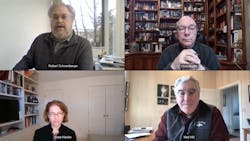Manufacturers ‘Want to See the Dust Settle’ in ’24
Many manufacturing leaders are experiencing “an outbreak of caution” when it comes to 2024 growth plans, an economist told an IndustryWeek webinar audience Nov. 20. But, he added, they are not giving up on growth “by any stretch.”
Chris Kuehl, managing director and co-founder of consulting firm Armada CI in Kansas City, said his regular survey work with the Fabricators and Manufacturers Association reflects a broader manufacturing trend. Companies are generally maintaining their production and working down inventories but not taking big shots when it comes to growth.
“None of them have given up their plans, but they’ve pushed them off,” Kuehl said. “What was going to be done this quarter is now two quarters down. What was going to be done early next year is now late next year. There’s this notion that ‘We want to see the dust settle. We want to see what things look like. Then we’ll pull the trigger or not.’”
The idea of leadership teams holding onto expansion plans but pushing out their timelines was one of several threads that emerged during a discussion between Kuehl, Kate Hardin of Deloitte and Ned Hill of The Ohio State University. Among the other major trends the trio highlighted during their conversation moderated by IndustryWeek’s Robert Schoenberger were:
- Workforce pressures are likely to increase – In addition to the premature retirements of some older workers during the pandemic, a wave of experienced technicians are starting to retire and the pipeline to replace them isn’t as large as it needs to be. Kuehl said this dynamic has moved from being a concern for large companies to firms with as few as 15 to 20 people.
- Stimulus tailwinds will pick up speed – Hardin, who is executive director of the Deloitte Research Center for Energy and Industrials, said recent legislation to boost the U.S. energy, infrastructure and semiconductor sectors could end up generating 3 million jobs annually during their lifespans. She noted that fields such as engineering and construction are only just getting back to something resembling normal operations even as they are starting to see dollars from the Inflation Reduction Act and Infrastructure Investment and Jobs Act begin to flow through the system in earnest.
- Companies are working hard to regionalize their operations – Hill, professor of economic development at Ohio State’s John Glenn College of Public Affairs, said leaders he is talking to “have a European strategy, a North American strategy and an Asian strategy” that will help them lower supply chain risks and better adjust to demand in those regions.
Considering those trends as well as other economic indicators such as slowing labor costs and a retail holiday season he expects “won’t be great,” Hill said he foresees slow growth in 2024 but no recession.
“I put all that together and say ‘soft landing,’” he said.
Asked about what might break the relative logjam in investment and capital spending, Kuehl said executives are getting used to today’s financial conditions—as well as the likelihood that, if Federal Reserve leaders have their way, those conditions won’t soon meaningfully change.
“We’re kind of going back to what we saw prior to all the turmoil around the pandemic,” he said of leaders’ attitudes. “They’re like, ‘Well, if it’s going to be this quarter like last quarter, I just need to go ahead and do what I’m going to do […] I’m starting to see companies do that now: ‘This is the new normal and I’m going to use it. I’m going to work with it.’”
To watch the full discussion among Hardin, Hill and Kuehl (registration required), follow this link.
About the Author
Geert De Lombaerde
Senior Editor
A native of Belgium, Geert De Lombaerde has been in business journalism since the mid-1990s and writes about public companies, markets and economic trends for Endeavor Business Media publications, focusing on IndustryWeek, FleetOwner, Oil & Gas Journal, T&D World and Healthcare Innovation. He also curates the twice-monthly Market Moves Strategy newsletter that showcases Endeavor stories on strategy, leadership and investment and contributes to other Market Moves newsletters.
With a degree in journalism from the University of Missouri, he began his reporting career at the Business Courier in Cincinnati in 1997, initially covering retail and the courts before shifting to banking, insurance and investing. He later was managing editor and editor of the Nashville Business Journal before being named editor of the Nashville Post in early 2008. He led a team that helped grow the Post's online traffic more than fivefold before joining Endeavor in September 2021.
